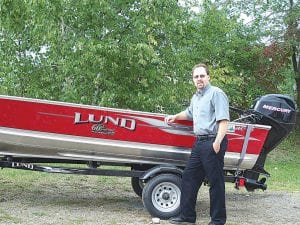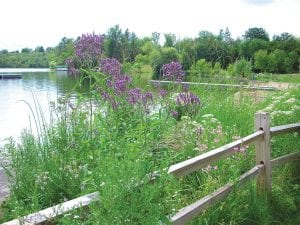What we do with shorelines affects Minnesota’s waters. Native plant buffers are a thin, green line protecting our rivers, lakes and wetlands from harmful pollutants and sediments. Many species rely on these natural habitats for food, shelter and travel.
Buffering shores with native plants helps stabilize shorelands and control erosion by slowing runoff. Areas with native plantings have less water runoff than areas with single, nonnative species such as bluegrass. Lawn grasses have roots of four to six inches, while native grasses have roots from two to six feet or more.
Native grasses, bushes, and trees trap sediments and pollutants that destroy fish spawning areas. This vegetation also absorbs nutrients that can cause excessive aquatic vegetation growth and algae blooms — that green scum on the water.
Mature trees are especially good for the shore. The extensive root networks from mature trees stabilize the slope. The shade from these giants also provides a cooling effect in the shallow near-shore waters, where 90 percent of a lake’s fish and wildlife species live or travel.

Conservationists with Common Sense (CWCS) is once again holding an exciting raffle. The grand prize is a 16-foot Lund with a mercury 25HP EFI four-stroke and trailer provided by Aronson’s Boat Works, Tower. According to CWCS, proceeds of the raffle will be used for legal fees in the lawsuit over the proposed US Forest Service South Fowl Snowmobile Trail Access in Hovland. CWCS and the local organization Arrowhead Coalition for Multiple Use support the Forest Service plan to provide access for residents and anglers between McFarland and South Fowl Lakes. Tickets are available at Our Place in Finland; Devil Track General Store; Trail Center; Nor’wester; and Gunflint Lodge. Pictured above is Paul Bernier of Grand Marais who was the lucky ticket holder in last year’s raffle, winning the boat, motor, and trailer.
Trees that have fallen into the water provide additional shelter and resting areas. Herons, turtles and largemouth bass love these over- and in-water structures. Fallen trees and branches also dampen wave impacts, preventing erosion.
Thethin, green line of woods, meadows, and marshes enhances the quality of Minnesota’s lakes and rivers. A natural shore provides shelter for fish, waterfowl, songbirds, frogs, turtles, mammals, and butterflies. The nectar, pollen, and seeds from native plants are food for butterflies, birds and other animals.
Some people fear that tall grasses might become a breeding area for mosquitoes, but quite the opposite is true. Native vegetation actually provides cover for insects like dragonflies, which feast on mosquitoes.
When it comes to buffers, wider is better. A buffer of 25 to 35 feet will filter half the phosphorous runoff from a shoreland lot, but even a 10-foot buffer will help. Whether you are building a new shoreland home or restoring your shore, natural landscaping is always best for our lakes, rivers and streams.
Everything we do on the land impacts our waters. Learn how you can help. Visit the Minnesota Department of Natural Resources Website at www.mndnr.gov.



Loading Comments